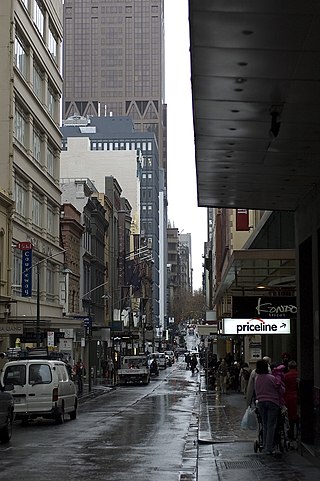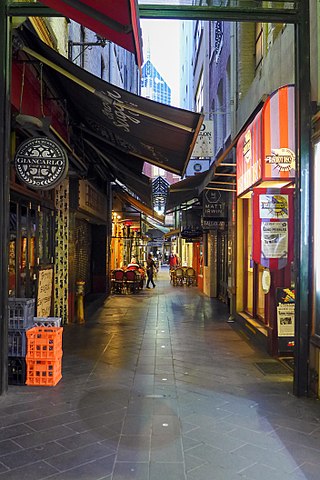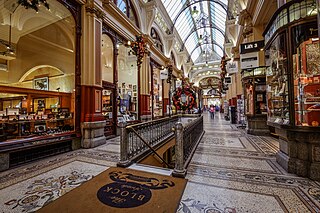
Bourke Street is one of the main streets in the Melbourne central business district and a core feature of the Hoddle Grid. It was traditionally the entertainment hub of inner-city Melbourne, and is now also a popular tourist destination and tram thoroughfare.

Collins Street is a major street in the central business district of Melbourne, Victoria, Australia. It was laid out in the first survey of Melbourne, the original 1837 Hoddle Grid, and soon became the most desired address in the city. Collins Street was named after Lieutenant-Governor of Tasmania David Collins who led a group of settlers in establishing a short-lived settlement at Sorrento in 1803.

Civic is the city centre or central business district of Canberra. "Civic" is a common name for the district, but it is also called Civic Centre, City Centre, Canberra City and Canberra, and its official division name is City.

Elizabeth Street is one of the main streets in the Melbourne central business district, Victoria, Australia, part of the Hoddle Grid laid out in 1837. It is presumed to have been named in honour of governor Richard Bourke's wife.

Chapel Street is a street in Melbourne, Victoria, running along the inner suburbs of South Yarra, Prahran, Windsor, St Kilda and St Kilda East.

Tourism is a significant industry in the state of Victoria, Australia. The country's second most-populous city, Melbourne was visited by 2.7 million international overnight visitors and 9.3 million domestic overnight visitors during the year ending December 2017.

Lonsdale Street is a main street and thoroughfare in the Melbourne central business district, Australia. It runs roughly east–west and was laid out in 1837 as one of Melbourne's original boundaries within the Hoddle Grid. The street extends from Spring Street in the east to Spencer Street in the west.

Melbourne Central is a large shopping centre, office, and public transport hub in the central business district of Melbourne, Victoria, Australia. The main tower is 211-metre (692 ft) high, making it one of the tallest buildings in Melbourne at the time it was built in 1991. Other parts of the complex include the Melbourne Central Shopping Centre, the underground Melbourne Central railway station and the heritage-listed Coop's Shot Tower.

St David's, previously known as St David's Shopping Centre, is one of the principal shopping centres in the city centre of Cardiff, Wales. It is in The Hayes area of the southern city centre. Following the extension of St David's 2 in 2009, St David's is the third busiest shopping centre in the United Kingdom.

Centre Place is a laneway and pedestrian precinct in Melbourne, Australia. It runs north from Flinders Lane to Collins Street, between Elizabeth Street and Swanston Street.

Little Collins Street is a minor street in the Melbourne central business district, Victoria, Australia.

Degraves Street is a pedestrian precinct and thoroughfare in the Melbourne central business district in Victoria, Australia. It is a short, narrow laneway that runs north–south from Flinders Street to Flinders Lane and is situated in-between Swanston and Elizabeth streets. Degraves, as the street is colloquially known, is famous for its alfresco dining options and because it epitomises Melbourne's coffee culture and street art scene. For these reasons it has also become a popular tourist destination.

Howey Place, formerly known as "Cole's Walk" is a shopping arcade in Melbourne, Victoria. It is a short, narrow covered laneway, running south from Little Collins Street between Swanston Street and Elizabeth Street in the central business district of Melbourne.

Block Place is a street in Melbourne. It is a short, narrow partially covered laneway, running south from Little Collins Street between Swanston Street and Elizabeth streets in the Melbourne central business district.

Flinders Lane is a minor street and thoroughfare in the Melbourne central business district of Victoria, Australia. The laneway runs east–west from Spring Street to Spencer Street in-between Flinders and Collins streets. Originally laid out as part of the Hoddle Grid in 1837, the laneway was once the centre of Melbourne's rag trade and is still home to boutique designers and high-end retailers including Chanel, now perched alongside numerous upscale hotels like the W Hotel Melbourne and Adelphi Hotel, loft apartments, cafes and bars.

The Block Arcade is a historic shopping arcade in the central business district of Melbourne, Victoria, Australia. Constructed between 1891 and 1893, it is considered one of the late Victorian era's finest shopping arcades and ranks among Melbourne's most popular tourist attractions.

The Melbourne central business district in Australia is home to numerous lanes and arcades. Often called "laneways", these narrow streets and pedestrian paths date mostly from the Victorian era, and are a popular cultural attraction for their cafes, bars and street art.

Emporium Melbourne is a luxury shopping centre on the corner of Lonsdale and Swanston streets in Melbourne, Australia. Occupying the former Lonsdale Street site of Myer's Melbourne store, Emporium opened in 2014 following extensive redevelopment. The centre includes a food court, specialty stores and several multi-level anchor retailers. Emporium forms part of a 188,000 square metres (2,020,000 sq ft) precinct of linked shopping centres in the Melbourne central business district, which also includes the Myer and David Jones city stores, Melbourne Central, General Post Office and Elizabeth Street's The Strand.
The Hotel Australia was a former hotel in Melbourne, Australia. The hotel was built in 1939 on the site of the former Cafe Australia, and was demolished in 1989.
























